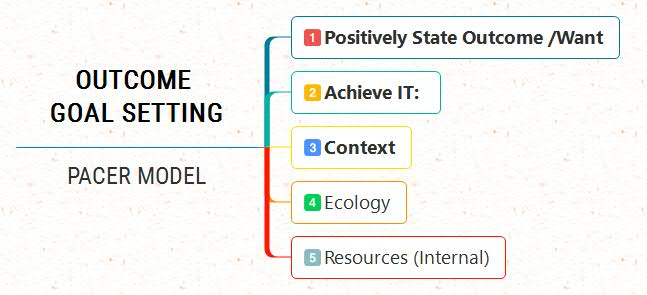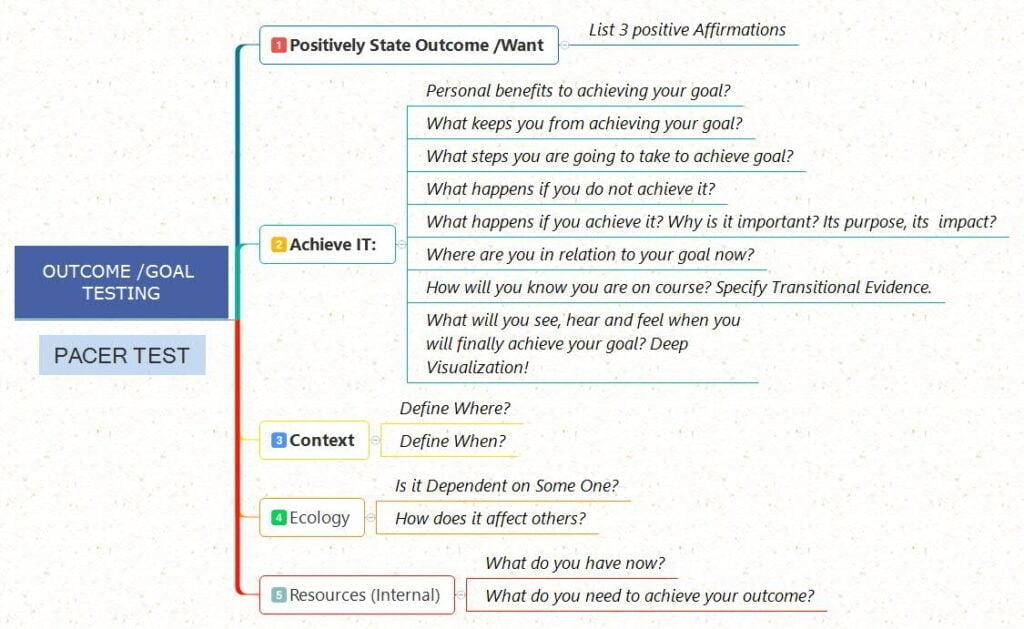PACER Goal Setting is a very powerful technique for creating well-formed outcomes. Once you have a goal in mind, you can use the PACER test to create well-formed outcomes. It helps to fine-tune your goals, makes the goals more empowering for you, and ultimately helps you achieve the goals. It is an NLP technique to create well-formed outcomes.
PACER Goal Setting
PACER Goal Setting
PACER test can be used to create well-formed goals.
Its an acronym for
P – Positively stated
A – Achievement Focussed
C – Contextual
E – Ecological
R – Resources

Now let us go through each of the 5 steps
P – Positively stated
Make sure the goal or outcome is stated in the positive. In general, the human mind is unable to process the word “Not” until it has recognized the positive sensation that the “Not” has come from.
If you set the outcome that “I am NOT going to eat any more chocolate”, the mind initially will create the sensation associated with “I AM going to eat more chocolate” and the body follows that sensation.
Also when setting well-formed outcomes, it should be stated as something that you will work towards rather than something you should avoid. Losing something or stopping something is likely to lead to avoidance strategies. So the goal of “Stop smoking” or “Lose weight” is less likely to work as you wish to avoid something to achieve the goal.
Ask the question of yourself “What do I want instead?” and create a goal or outcome that you can work towards.
A – Achievement Focussed
How will you know you’ve succeeded? What are your measures of success or achievement? What will you see, hear and feel that provides you with that sensory-based evidence that tells you that you have got it?
Some Questions to Ask
- What are the Personal benefits of achieving your goal?
- What keeps you from achieving your goal?
- What steps you are going to take to achieve the goal?
- Ask yourself, is your goal achievable?
- How will you achieve it?
- How will you know when you have succeeded?
- How will you measure your progress?
- What happens if you do not achieve it?
- What happens if you achieve it? Why is it important? Its purpose, its impact?
- Where are you in relation to your goal now?
- How will you know you are on course to achieving the goal? Specify Transitional Evidence.
- What will you see, hear and feel when you will finally achieve your goal? Deep Visualization! When thinking about achievement focus on the sensory evidence that will tell you that you’ve succeeded.
- What will you see?
- What will you hear?
- What will you feel?
- We are sensory creatures and so success should be sensory!
You might also wish to consider Lao Tzu’s words that “A journey of 1000 miles starts with a single footstep”.
“A journey of 1000 miles starts with a single footstep”.
Lao Tsu
No matter how well-defined a goal is, action must be taken to start the journey. This gives the traveler the motion and momentum to achieve the goal. So ask yourself, “Can I start and maintain the effort for this outcome?” and “What is the next smallest step that I need to take to start/continue my journey towards this goal?”
C – Contextual
This is the opportunity to define with whom, where, and when you want this outcome and also with whom, where and when you do not want it.
There may be some situations or contexts in which this outcome is inappropriate (for example a personal goal may not be appropriate at work). This is also the stage at which to define whether there is a specific length of time that is valid for this outcome.
E – Ecological
It is important to consider the effect of your achievement upon the wider system of your life (either professional, personal, or as a whole). Who else will be affected (this includes clients, customers, family, and line managers), and how will they feel? What might the effect be upon the team, and the organization (which includes resources such as finance and time)? You might find that you may have to give up something in order to achieve this outcome.
There may also be underlying unconscious considerations that you may have to consider. Here are four questions that you can ask yourself (or get someone else to ask you). Be aware of all the indicators inside you rather than just the conscious answer that may appear.
- If you get this goal, what will you have?
- If you get this goal, what won’t you have?
- If you do not get this goal, what will you have?
- If you do not get this goal, what won’t you have?
R – Resources
This is a chance to allow yourself to free your conscious and unconscious mind and brainstorm everything that you might need to support you in achieving this outcome. As well as material things such as equipment, IT, or finances, there may be other people that you could role model as they have already achieved this before you. You should also ask and recognize what you need within yourself including the qualities and skills that you already have or may need in the future.
In addition, it’s good to recognize how much direct control you have over the outcome and its journey and how much other people will be involved in its achievement.
Summary: Well-Formed Outcomes using PACER Goal Setting
PACER Goal Setting or PACER Test can be a great tool to use to achieve your goals. It helps us to create well-formed goals.

